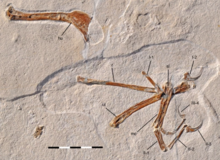Alcmonavis
| Alcmonavis | |
|---|---|

| |
| Holotype specimen | |
| Scientific classification | |
| Domain: | Eukaryota |
| Kingdom: | Animalia |
| Phylum: | Chordata |
| Clade: | Dinosauria |
| Clade: | Saurischia |
| Clade: | Theropoda |
| Clade: | Avialae |
| Genus: | †Alcmonavis Rauhut et al., 2019 |
| Type species | |
| †Alcmonavis poeschli Rauhut et al., 2019
| |
Alcmonavis is a basal genus of avialan dinosaur that during the Late Jurassic lived in the area of present Germany. The only named species in the genus is Alcmonavis poeschli. Its only known fossil was originally reported as a specimen of Archaeopteryx.
Discovery and naming
Amateur paleontologist Roland Pöschl systematically excavates the Alte Schöpfel quarry on the Schaudiberg, at Mühlheim near Mörnsheim in Bavaria. In November 2017, he discovered a slab showing a right wing of a primordial bird. The piece was prepared by Uli Leonhardt.[1] In 2018, it was reported as a thirteenth specimen of Archaeopteryx. Subsequent research, however, indicated that it represented a species new to science.
In 2019, the type species Alcmonavis poeschli was named and described by Oliver Walter Mischa Rauhut, Helmut Tischlinger and Christian Foth. The generic name combines the old Celtic name of the Altmühl River meandering through the region of the find, Alcmona, with a Latin avis, "bird". The specific name honours Pöschl as discoverer.[1]
The holotype, specimen SNSB-BSPG 2017 I 133, has been found in a layer of the Mörnsheim Formation dating from the early Tithonian. It consists of a nearly complete but only partially articulated right wing. The fossil is part of the collection of the Bayerische Staatssammlung für Paläontologie und Geologie after being purchased by the Bavarian state.[1]
Description
The length of the holotype was estimated at 111% of that of the largest known Archaeopteryx specimen, the Solnhofener exemplar. The estimated humerus length is about nine centimetres.
No
Classification
Rauhut et al (2019) placed Alcmonavis in a
| Avialae |
| ||||||||||||||||||||||||||||||||||||||||||
References
- ^ PMID 31084702.
